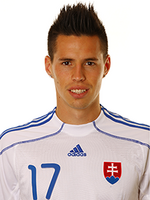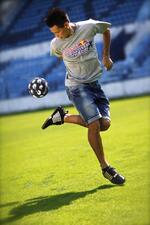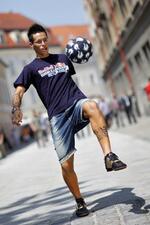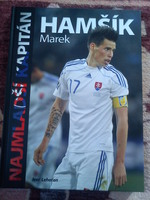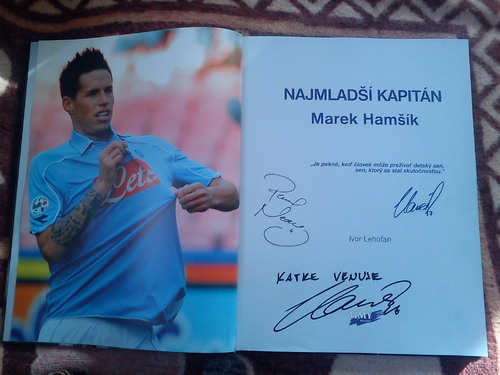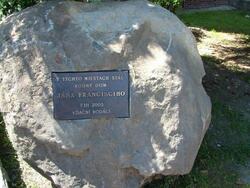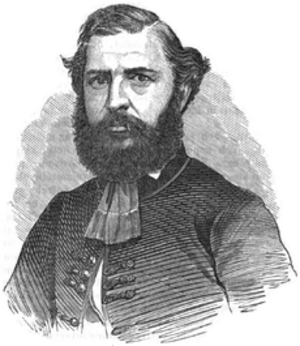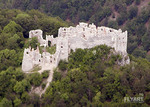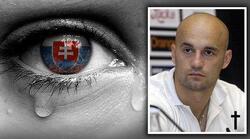-
Par Katka le 24 March 2013 à 17:48
Great footballer was born on Monday, 27 July 1987, evening (18:30). One of the best, and the most recognized Slovak footballers in the world.
Both his father Richard and his mother Renáta were 18 when their son was born. They bought him his first football boots even before he was born. That time it was obvious that Marek will be a footballer like his father. Marek’s younger sister Michaela became handball player like her mother.
Marek was only four at the time his father enrolled him in Jupie Podlavice club. Most of the time he played against the older players, however, he stood out amongst them. He was regularly being announced as the best player and scored one goal after another. In the autumn 1998 he scored 16 goals in the match in Dolná Strehová in county tournament, which nobody beat his record ever since.
Few weeks later Marek changed the club. He moved to Slovan Bratislava. There he won the title of the Champions league in junior as well as youth category.
In Octobre 2003 at the Qualification Tournament of representation Under 17 Marek was noticed by Mauricio Michelli manager of Brescia. Contract was signed in December, and Marek should have moved to Brescia in the summer 2005. He rapidly became one of the key members of the team and from the beginning 2005 he regularly appeared in Senior team nomination. He scored the first goal for Brescia in January 2006, in Talian cup against AC Milan!
In the summer 2007, football clubs started transfer battle over Marek. The winner was Napoli. Immediately during his first season he proved himself the big star of the team, he scored 9 goals in 37 matches. In season 2008/09 he scored 9 goals in 32 matches.
Since his transfer to Slovan (in 2004) he started to appear at the national teams at junior level. He made his debut in Senior team in February 2007 during his stay in Brescia. He scored his first goal in national team in October against San Marino. He contributed significantly to historical qualification of Slovakia for the World Cup 2010 in South Africa. These days it is not possible to imagine Slovak team without Marek Hamsik – at the age of 20 he became the captain of the national team.
PROFILE :
Name: Marek Hamšík
Birth: 27. july 1987 in Banskej Bystrici
Nationality: slovak
Height: 183 cm
Weight: 73 kg
Marital status: single
Girlfriend: Martina
Sons: Christian, Lucas
Parents: Renata a Richard
Sister: MichaelaFAVOURITE
Food: bryndzové halušky
Drink: coca-cola
Club: as child Barcelona a Manchester United, nowadays Neapol
Color: blue
Film: comedy
Music: slovak rep and hip hop
Webpage: profutbal
Shoe size: 45
Idol: Pavel Nedveď
Nickname: žaba, Marechiaro
Dress number: 17his parfum
The book about Marek. I have one with his signature and dedication "Katke venuje Hamšík" .
By Katka (:
 2 comments
2 comments
-
Par Katka le 24 March 2013 à 17:35
Martin Škrtel
Second great footballer was born 15 December 1984 in Handlová, Slovakia.
Martins career began in a city that was surrounded by fashion or hockey much more than football. It was his father who led him to football instead of hockey and skiing.
Very soon it turned out to be a breaking point of his career. Mostly due to a Kirin Cup tournament held in Japan. This was the place where Martin first cought the eye of big club scouts. They all saw what now everyone sees in the Champions League or Premier League – his fighting spirit, strong head and his good attitude in games. And when Zenit St. Petersburg came knocking, the answer was yes.
The former Zenit manager Vlastimil Petrzela said : „Since the last 21 years that I work as a coach I have never seen such a good player. Martin made a huge step forward in the last season. He is extremely self confident and he has a great future ahead of him.“.
When Zenit won the league in 2007 and Martin finished amongst the 30 best players of the league, it was Tottenham, Everton, Newcastle United and Valencia that formed a long queue of admirers willing for his signature. „I came to Zenit as a 19-year old and I really liked this place. I was chosen by Vlastimil Petržela. I had my chances in the beginning but I was too young probably because my performances on the pitch were not ideal. But as time went by I became more matured and the arrival of Mr. Advocaat helped me a lot as well. I couldn´t end my stay in a better way – by becoming a Champion of Russia. I won the Slovak Footballer of the Year competition as well.“
A bomb, a dream came true, a moment of joy by becoming the most expensive defensive signing in Livepools long history. On January 11th he signed a contract with the Reds. Liverpool paid 6,5 million pounds for his services. „He is aggressive, quick, is good in the air and I think he's a very good player for the future and also for the present.“ These were the first words of Mr. Rafa Benitez after he has signed Martin.
And then it went all so fast. Maybe even Martin didn´t expect to come on the pitch so soon. He played his first 20 Premier League minutes on January the 21st against Aston Villa (2:2). He made his debut in the starting eleven a couple days later. It was really not of those to remind. Liverpool won against a minor Havant & Waterlooville 6:2 but Martin was involved in both goals in Liverpools net. He even scored an own goal. And what does he think of this dream job in Anfield now? „My dream came true by signing for this club.“
By Katka (:
 your comment
your comment
-
Par Katka le 21 March 2013 à 03:18
Ján Francisci-Rimavský, real name John Francisci, also Francisci Janko, Janko Rimavský pseudonyms, Slavoľub, Wrocław Rimavský and others (* 1 June 1822, Hnúšťa - † March 7, 1905, Martin) was a Slovak poet, writer, translator and journalist a politician, co Stur.
In 1839 John Francisci studied at the Evangelical Lyceum in Bratislava, where he became a supporter Štúrovo ideas and opinions. The protest against the ban Stur talks with a group of students went to study in Levoca, where he became deputy Professor Michael Hlavacek (1844 - 1845), who in 1832 founded the Society of Czech language and literature-Slavi.
by Mirka
 your comment
your comment
-
Par Katka le 23 February 2013 à 09:59
Juraj Jánošík, called the Slovak Robin Hood, became the greatest Slovak legend pictured in many films, paintings, literary and dramatic works. “He took from the rich and gave to the poor” is the famous statement associated with him.
This probably best-known highwayman in the whole Austro-Hungarian Empire was born in 1688 in Terchová,north-west Slovakia. He grew up in an isolated settlement near Terchová and at the age of twenty he voluntarily joined the troops of Ferenc Rákoczi.
After the defeat of the troops by the emperor´s army in the battle at Trenčín he was taken captive and later he joined the guard troops of the emperor. He served as the guard of prisoners at the Bytča castle where he met a prisoner called Tomáš Uhorčík, the captain of the highwaymen from Kysuce. Later Juraj Jánošík returned to Terchová, but he did not stay long. After Uhorčík had escaped from prison, Jánošík joined his group in 1711 (he made his solemn highwayman´s oath on St. Michael´s day - 29th September). Later he was elected captain of the group but his captainship did not last longer than a year
Most of their victims were rich merchants. Under Jánošík's leadership, the group was exceptionally chivalrous: They did not kill any of the robbed victims and even helped an accidentally injured priest. They are also said to share their loot with the poor and this part of the legend may be based on the facts too.
Jánošík was captured in autumn 1712 and detained at the mansion of Hrachovo, but was released soon afterwards. He was captured again in spring of 1713, in the Uhorčík's residence in Klenovec. He was arrested in 1713 by the soldiers from Liptov and after a trial that also involved torture he was executed on 18th March 1713 in Liptovský Mikuláš.
During the short period of his captainship he made a lot of robberies. He surely belonged to “extremely dangerous elements” because only those were executed by hanging on a hook.
Nowadays the popular festival of folklore music “Jánošíkove dni” bears his name and it is held in Terchová every year. A huge statue of this Slovak national hero is overlooking the village and the museum Múzeum Juraja Jánošíka in Terchová is also worth visiting.
by Daniela
 your comment
your comment
-
Par Katka le 14 February 2013 à 17:14
Early life
Ľudovít Štúr was born on 29 October 1815 in Uhrovec in the Kingdom of Hungary (in the same house where Alexander Dubček was later born) as the second child of Samuel and Anna Štúr. He was baptized in the Evangelical Lutheran church in Uhrovec. He acquired his basic education, including the knowledge of Latin, from his father Samuel, who was a teacher. From 1827–1829, he studied at Győr, where he attended a lower grammar school. There he improved his knowledge of history, and German, Greek and Hungarian languages. These studies provoked his admiration of Pavel Jozef Šafárik, Ján Kollár and Jiří Dobrovsky. In 1829, he decided to change school.
From 1829–1836, Ľudovít Štúr studied at the prestigious Lutheran Lýceum (preparatory high school and college) in Pressburg and became a member of the Czech-Slav Society, which stimulated his interest in all Slav nations. There was a famous Department of the Czechoslovak Language and Literature of the old Professor Juraj Palkovič at the school, the only such department at a Protestant school of higher education in the 19th century Hungary.
In 1831, Ľudovít Štúr wrote his first poems. From January–September 1834, he temporarily interrupted his studies due to lack of finances and returned to Uhrovec, where he worked as scribe with Count Karol Zay. Later that year he resumed his studies, was active in the historical and literary circle of the Czech-Slav Society, was responsible for the correspondence with members of the Society, gave private lessons in the house of a merchant in Bratislava, taught younger students at the Lýceum and established contact with important foreign and Czech scholars. On 17 December 1834, he was elected secretary of the Czech-Slav Society at the Lýceum.
Slovak national movement.
In May 1835, Ľudovít Štúr persuaded Jozef Hurban to become involved in the Slovak national movement. Also that year, he was co-editor of the Plody ("Fruits") almanac, a compilation of the best works of the members of the Czech-Slav Society, including poems of Štúr's. He became vice-president of the Czech-Slav Society, teaching older students at the Lyceum the history of the Slavs and their literatures.
In 1836, Štúr wrote a letter to the important Czech historian František Palacký, where he stated that the Czech language used by the Protestants in Upper Hungary had become incomprehensible for the ordinary Slovaks, and proposed the creation of a unified Czechoslovak language, provided that the Czechs would be willing to use some Slovak words – just like Slovaks would officially accept some Czech words. But the Czech were unwilling to accept this, and so Štúr and his friends decided to introduce a completely new Slovak language standard instead.[citation needed] On 24 April 1836, the famous trip to Devín Castle (Dévény, now part of Bratislava) by the members of the Slovak national movement took place, led by Štúr as the vice-president of Czech-Slav Society. The beginning of his group's extensive efforts on behalf of national awareness are linked to this visit to the ruins of Devín Castle, woven about with legends of the past with reminders of Great Moravia. The members of the Czech-Slav Society swore here to be true to the national cause, deciding to travel around Upper Hungary to drum up support for their ideas. At the castle, they also adopted additional Slavic names (e.g., Jozef Hurban became Jozef Miloslav Hurban, etc.).
From 1836–1838, as deputy (non-stipendiary assistant) for Professor Palkovič, Chair of the Czechoslovak Language and Literature at the Lyceum, where he was previously student, he taught history of Slavic literature. He continued to write poetry and under his leadership, the number of members of the Czech-Slav Society was constantly increasing. In this year, a poem of Štúr's was published in printed form for the first time: Óda na Hronku ("An ode to Hronka"). In April 1837, the Czech-Slav Society was prohibited due to student commotion at the Lyceum. One week later Štúr founded the Institute of the Czechoslovak Language and Literature, within which the activities of the Czech-Slav Society continued. In that year he continued to write articles for newspapers and journals, including Tatranka, Hronka, Květy (Czech), Časopis českého musea, Danica (Croatian) and Tygodnik literacki (Polish).
[edit]Travels in Germany and early political works.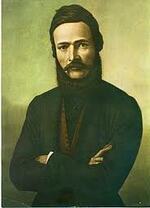
From 1838–1840, he attended the (Protestant) University of Halle in Germany, where he studied linguistics, history and philosophy. He was influenced by the works of the German philosophers Georg Wilhelm Friedrich Hegel and Johann Gottfried Herder. Also during this period, his poetic cycle Dumky večerní ("Evening thoughts" written in Czech) was published in the Czech journal Květy. He left Pressburg for Halle in September 1838. On his way to Halle, he spent more than one month in Prague surrounded by Czech patriots. In the spring of 1839, Štúr made a long journey to the Upper and Lower Lusatia in Germany (inhabited by Slavs) and got in touch with the Slavs there. He wrote the short travelogue Cesta do Lužic vykonaná na jar 1839 ("A journey to Lusatia made in the spring of 1839"), written in Czech and published in the Czech journal Časopis českého musea.
In 1840, he returned to Bratislava via Prague and Hradec Králové (Königgrätz), where he spent some time in the house of the publisher Jan Pospíšil. From October, he was once again working as deputy for Professor Palkovič at the Department of the Czecho-Slav Language and Literature at the Evangelic Lutheran Lyceum, teaching courses of grammar and Slav history, and continuing his activities at the Institute of Czechoslovak language.
During 1841–1844, Štúr was co-editor of Palkovič's literary magazine Tatranka. In 1841, he started activities aimed at publishing a Slovak political newspaper. He wrote defensive and polemic texts as well as his Starý a nový věk Slovákov ("The old and the new age of the Slovaks"), written in Old Czech and published in 1935 (in Slovak only in 1994). On August 16, 1841, Štúr and his friends ascended Kriváň (a symbolic mountain in Slovak culture), an event that is now commemorated by annual excursions to its summit. In 1842, he initiated the first Slovenský prestolný prosbopis, a Slovak petition to the Royal Court in Vienna requiring the government to stop national persecutions by the Hungarians in Upper Hungary. His application for a licence to publish a newspaper was turned down in the same year.
Codification of Slovak
On 2 February 1843, in Pressburg, Štúr and his friends decided to codify the Slovak language standard used today, based on central Slovak dialects – a common language that would unify all Slovaks speaking many different dialects. From 26-29 June 1843, a special committee met to investigate against the Institute of Czechoslovak Language at the Lyceum, also interrogating Štúr. Štúr was forced to leave his position at the Institute and 22 students supporting Štúr also left the institution and started their studies at Evangelical lyceum in Levoča.
In July 1843, his defensive work Die Beschwerden und Klagen der Slaven in Ungarn über die gesetzwidrigen Übergriffe der Magyaren ("The complaints and grievances of the Slavs in Hungary about the illegal misfeasances of the Hungarians"), which editorial offices in the 19th century Hungary had refused to publish, was published in Leipzig, Germany. From 11-16 July 1843, at the parish house of J. M. Hurban in Hlboké, the leaders of the Slovak national movement – Štúr, J. M. Hurban and M.M. Hodža – agreed on how to codify the new Slovak language standard and how to introduce it to the public. On 17 July 1843, they visited Ján Hollý, an important writer and representative of the older Bernolák Slovak language standard, in Dobrá Voda and informed him about their plans. On 11 October 1843, although the committee did not find anything illegal about Štúr's activities, Štúr was ordered to stop lecturing and was removed from the function of deputy for Prof. Palkovič. However, Štúr continued to give lectures. On 31 December 1843, he was definitively deprived of the function of deputy for Prof. Palkovič. As a result, in March 1844, 22 students left Pressburg in protest; 13 of them went to study at the Evangelical lyceum in the town of Levoča. One of the supporting students was Janko Matuška, who by this opportunity created a hymnical song Nad Tatrou sa blýska, which later became official anthem of the Slovak republic.
From 1843–1847, Štúr worked as a private scientist. In 1844, he wrote Nárečja slovenskuo alebo potreba písaňja v tomto nárečí ("The Slovak dialect or the necessity to write in this dialect"). On 19 May 1844, a second Slovenský prestolný prosbopis was sent to Vienna, but had little influence. But in 1844 other Slovak authors (often Štúr’s students) started to use the new Slovak language standard. On August 27, he participated in the founding convention of the Slovak association Tatrín, the first nation-wide association.
On 1 August 1845, the first issue of Slovenskje národňje novini ("Slovak National Newspaper"; published till 9 June 1848) was published. One week later, its literary addendum Orol Tatranský ("The Tatra Eagle"; published till 6 June 1848) was also published. In this newspaper, written in the new Slovak language, he gradually shaped a Slovak political program. He based this on the precept that the Slovaks were one nation and that they therefore had a right to their own language, culture, schools, and particularly political autonomy within Hungary. The projected expression of this autonomy was to be a Slovak Diet. Also that year, his brochure Das neunzehnte Jahrhundert und der Magyarismus ("The 19th century and Magyarism"), written in German, was published in Vienna.
Nauka reči slovenskej, his most important work
In 1846, Štúr got to know the yeoman Ostrolúcky family in Zemianske Podhradie, who later helped him to become a deputy in the Hungarian Diet in Pressburg. He also fell in love with Adela Ostrolúcka. In addition, his books Nárečja Slovenskuo alebo potreba písaňja v tomto nárečí (1844) and Nauka reči Slovenskej ("The Theory of the Slovak language") were published in Pressburg. In Nárečia Slovenskuo, he refused Kollár's concept of only four Slavic tribes (Russians, Poles, Czechs and Southern Slavs) and listed reasons for the introduction of the new language, which is based on central Slovak dialects and uses phonetic spelling. In Nauka reči Slovenskej he explained the grammar of the new language standard. In the same year, the upset Kollár and his followers published the compilation work „Hlasové o potřebě jednoty spisovného jazyka pro Čechy, Moravany a Slováky“ ("Voices in favour of the necessity of a unified literary language of the Czechs, Moravians and Slovaks"), written in Czech.
In August 1847, at the 4th convention of the Tatrín association in Čachtice, Catholics and Protestants "definitively agree to use only the newly codified Štúr language standard". On 30 October 1847, he became a deputy for the town of Zvolen (Zólyom) in the Hungarian Diet in Pressburg. From 17 November 1847 to 13 March 1848, he gave five important speeches at the Diet, in which he required the abolishment of serfdom in Hungary, the introduction of civil rights and the use of the Slovak language for teaching in elementary schools. The Diet met only until 11 April 1848 due to the 1848 revolution.
1848/49 Revolution
On 1 April 1848 in Vienna, Štúr and his colleagues prepared the Slavic Congress of Prague. On 20 April 1848, he arrived in Prague on the invitation of the Czech J. V. Frič, where he won the support of Czech students that were members of the association Slávie regarding his attempts to enforce the Slovak language. On 30 April 1848, he initiated the establishment of "Slovanská lipa" (Slavic lime) in Prague – an association aiming at promoting the mutual cooperation of the Slavs.
In May 1848, he was one of the authors of the official petition Žiadosti slovenského národa ("Requirements of the Slovak Nation"). The Žiadosti slovenského národa was publicly declared in Liptovský Svätý Mikuláš, with Janko Francisci as the reader. In it, the Slovaks demanded autonomy within Hungary, a proportional representation in the Hungarian Assembly, the creation of a Slovak Diet to administer their own region, where Slovak would become the official language and educational institutes from elementary schools to universities would use Slovak. They also called for universal suffrage and democratic rights – e.g., freedom of the press and public assembly. They requested that peasants be released from serfdom and that their lands be returned to them. But on 12 May 1848, the Hungarian government issued a warrant on the leaders of the Slovak movement: Štúr, Hurban and Hodža. The persecuted Štúr arrived in Prague on 31 May 1848. On 2 June 1848 he participated in the Slavic Congress there.
On 19 June 1848 he went to Zagreb, Croatia, because the Slavic Congress was interrupted by fighting in Prague, and becomes an editor of the Croatian magazine Slavenski Jug. With financial support from some Serbs, he and J. M. Hurban started to prepare an uprising against the Hungarian government. The "Slovak Uprising" occurred between September 1848 and November 1849. In September 1848, Štúr travelled to Vienna and participated in the preparations for the Slovak armed uprising. On 15-16 September 1848, the Slovak National Council, the supreme Slovak political and military organisation consisting of Štúr, Hurban and Hodža (as politicians) and the Czechs B. Bloudek, F. Zach and B. Janeček (as military experts), was created in Vienna. On 19 September 1848, in Myjava, the Slovak National Council declared independence from the Hungarian government and called on the Slovak nation to start an armed uprising. But the Council only managed to control the surrounding Slovak region.
Štúr, Hurban and others met in Prague on 7 October 1848 to discuss further proceedings concerning the uprising. Upon returning to Vienna in November, Štúr and Slovak volunteers – on one of the so-called Volunteer Campaigns – traversed northern Hungary from Čadca up to Prešov until March in 1849. On 20 March 1849, he participated in a deputation that visited the Austrian king, in the Czech town of Olomouc, presenting him requirements concerning the Slovak nation. From March until June, Štúr – along with Hurban, Hodža, Bórik, Chalúpka and others – negotiated in Vienna about a solution to the Slovak requirements. But on 21 November 1849, the Slovak volunteer corps was officially demobilized in Pressburg, and the disappointed Štúr retreated to his parents' home in Uhrovec.
Later life
The later years of Štúr's life saw him engage in further scientific and literary work. In the autumn of 1850 he attempted but failed to receive a licence to publish a Slovak national newspaper. In December of that year he participated in a deputation to Vienna concerning Slovak schools and the Tatrín association. Several personal tragedies also occurred during his later life. His brother Karol died on 13 January 1851. Štúr moved into the house of Karol's family in Modra (near Pressburg) to care for his seven children; he lived there under police supervision. On 27 July 1851, his father died; his mother moved to Trenčín.
In October 1851 he participated in meetings in Pressburg concerning a reform of the codified Slovak language standard. The reform, involving mainly a transition from the phonetic spelling to an etymological one, was later introduced by M. M. Hodža and Martin Hattala in 1851–1852, but Štúr, among others, also participated in the preparations. The result of this reform was the Slovak language standard still used today, with minor changes.
In Modra in 1852, Štúr finished his essay O národních písních a pověstech plemen slovanských ("On national songs and myths of Slavic kins"), written in Czech and published in Bohemia the next year. In addition he wrote his important philosophic book Das Slawenthum und die Welt der Zukunft ("The Slavdom and the world of the future"), written in German, published in Russian in 1867 and 1909 (published in German in 1931; in Slovak in 1993). Among other things, he recapitulated there the events that brought the Slovaks in their disconsolate situation at that time and suggested as a solution to cooperate with Russia, thus basically passing from his Slovak national idea to pan-Slavism.
In 1853, his platonic girlfriend, Adela, died in Vienna on March 18. He also went to take care of his ill mother in Trenčín, before she died on 28 August 1853. The only compilation of his poetry, Spevy a piesne ("Singings and songs") was also published in Pressburg that year. On 11 May 1854, he held a speech at the unveiling of the Ján Hollý monument (Ján Hollý having died in 1849) in Dobrá Voda; he had also written a poem in honour of that man.
On 22 December 1855, Štúr inadvertently shot and wounded himself during a hunt near Modra. In the last days of his life, he was mainly supported by his friend Ján Kalinčiak. On 12 January 1856, Ľudovít Štúr died in Modra. A national funeral was held there in his honour.By Renka
 2 comments
2 comments
-
Par Katka le 14 February 2013 à 16:42
Pavol Demitra (29 November 1974 – 7 September 2011) was a Slovak professional ice hockey player. He played sixteen seasons in theNational Hockey League (NHL), two in the Czechoslovak First Ice Hockey League (CFIHL)/Slovak Extraliga and one in the Kontinental Hockey League (KHL). Known as an offensive player, Demitra was a first- or second-line forward throughout his career.
After a season with HC Dukla Trenčín in the CFIHL, Demitra was selected 227th overall in the 1993 NHL Entry Draft by the Ottawa Senators. He subsequently left Slovakia to join the Senators organization and played three seasons between the NHL and the American Hockey Leaguewith Ottawa's minor league affiliate, the PEI Senators. Demitra began the 1996–97 season in a contract holdout with the Senators, resulting in him being traded to the St. Louis Blues in November 1996. After spending the majority of his first season with St. Louis organization in theInternational Hockey League, he secured a regular roster spot with the Blues in 1996–97. Demitra spent his most successful seasons with St. Louis, being named to three NHL All-Star Games (1999, 2000 and 2002) and winning the Lady Byng Memorial Trophy in 2000. He achieved the 30-goal mark three times and the 90-point mark once with the Blues. Due to the 2004–05 NHL lockout, Demitra returned to HC Dukla Trenčín for one season. Upon returning to the NHL the following year, he signed as a free agent with the Los Angeles Kings. After one year with Los Angeles, he was traded to the Minnesota Wild, where he played on the team's top line with winger Marián Gáborík. In July 2008, he became an unrestricted free agent and signed with the Vancouver Canucks.
Demitra left the NHL after a two-year stint with the Canucks, joining Lokomotiv Yaroslavl of the Kontinental Hockey League. Demitra spent the entire 2010–11 KHL season with Lokomotiv, netting 18 goals and 43 assists in 54 games. On 7 September 2011, the eve of the 2011–12 KHL season, a plane carrying the Lokomotiv players and coaching staff crashed shortly after takeoff. 44 passengers, including Demitra, died as a result.
In international competition, Demitra began his career with Czechoslovakia. He won a gold medal at the 1992 IIHF European U18 Championship and a bronze medal at the 1993 IIHF World U20 Championship. After the country split in 1993, Demitra began competing forSlovakia. Beginning in 1996, he played in six IIHF World Championships, winning a bronze medal in 2003 and captaining his country in 2011. In 1996 and 2004, Demitra participated in the NHL-sanctioned World Cup. He was also a three-time Olympian and played his first tournament in 2002. Four years later, he captained Slovakia and in 2010, where he led all scorers in points and was named to the tournament's All-Star Team.
The 2011 Lokomotiv Yaroslavl plane crash occurred on 7 September 2011, at 4:02 PM local time, when a Yakovlev Yak-42 passenger aircraft, carrying the entire hockey team of Lokomotiv Yaroslavl of the Kontinental Hockey League (KHL), crashed near Yaroslavl, Russia, on its way to Minsk, Belarus, to start the 2011–12 KHL season.
The club's entire roster was killed in the plane crash. The airplane caught fire and crashed shortly after take-off, a mere 4 kilometers from the Tunoshna airport. Preliminary reports said that 43 of the 45 passengers on board had been killed, including the entire roster and 4 youth players, and that the remaining one, Alexander Galimov, was in critical condition. However, Galimov died a few days later. Demitra's agent, Matt Keator, confirmed his client's death.
Demitra is survived by his wife Maja and two children, Lucas and Zara. He was predeceased by his infant son, Tobias.
Following his death, the elementary school in Dubnica nad Váhom, which he had attended, and the ice hockey stadium in Trenčín, where he started his successful career together with famous Slovak ice players Zdeno Chára, Marián Hossa, Marcel Hossa, and Marián Gáborík were named after him.♥
By Renka
 your comment
your comment Follow this section's article RSS flux
Follow this section's article RSS flux Follow this section's comments RSS flux
Follow this section's comments RSS flux
Being 14 In Europe... What else ???





 Twitter
Twitter del.icio.us
del.icio.us Facebook
Facebook Digg
Digg Technorati
Technorati Yahoo!
Yahoo! Stumbleupon
Stumbleupon Google
Google Blogmarks
Blogmarks Ask
Ask Slashdot
Slashdot
